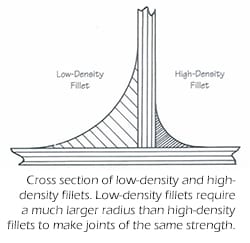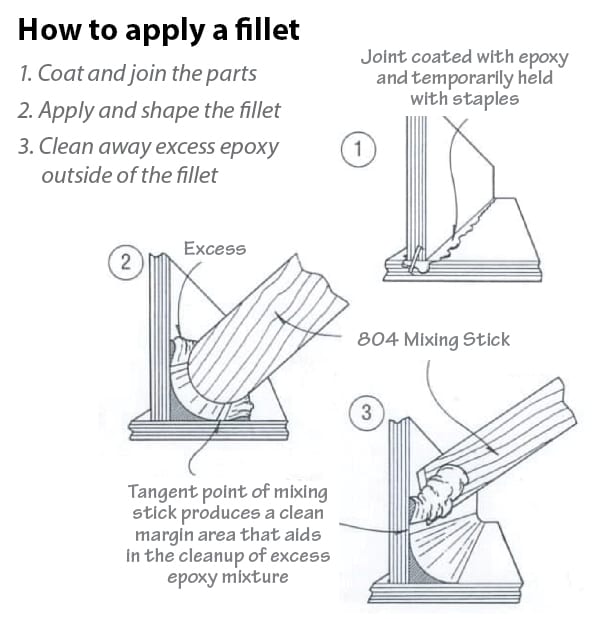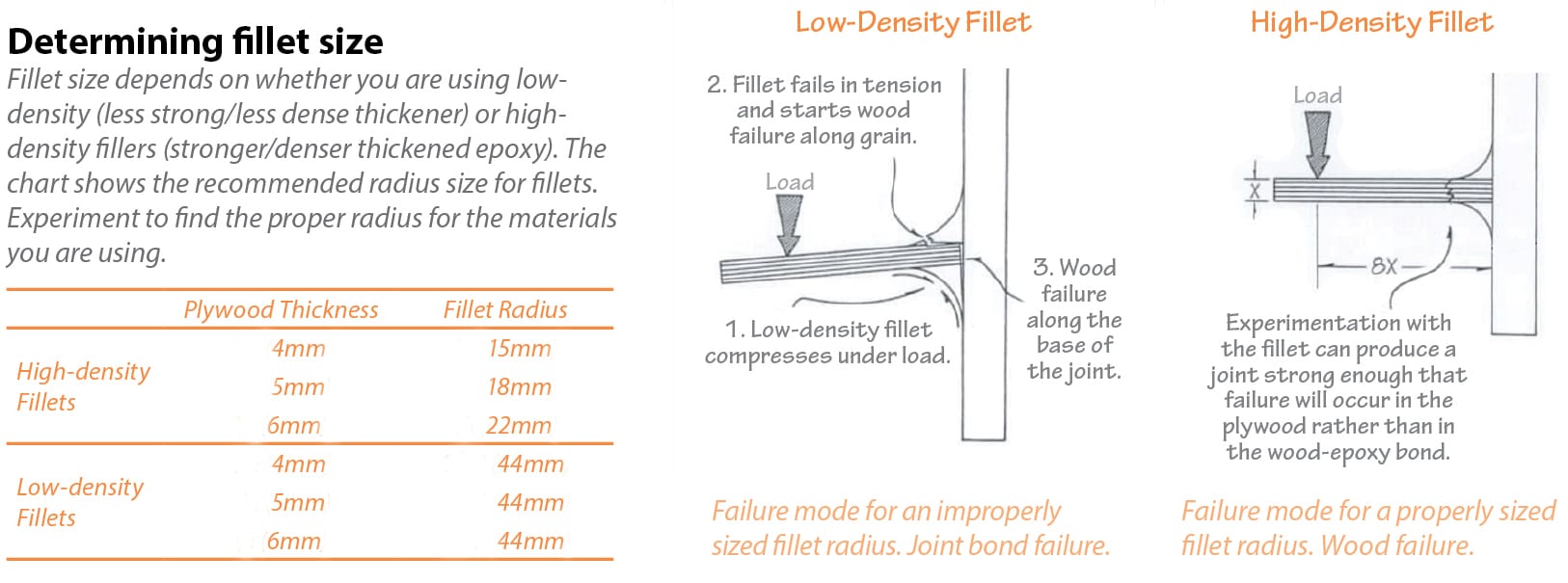Bonding with Fillets



A fillet (fil’it) is a cove-shaped application of thickened epoxy that bridges an inside corner joint. It is excellent for bonding parts because it increases the surface area of the bond and serves as a structural brace. All joints that will be covered with fibreglass cloth will require a fillet to support the cloth at the inside corner of the joint.
Gluing plywood structures together with epoxy fillets saves considerable time constructing the joints and reduces overall weight of the structure compared to more traditional methods using wooden cleats and screws. The strength and gap-filling qualities of epoxy eliminates the need for precisely fitted wood cleats that otherwise require time and skill to create. When gluing with conventional adhesives, that are non-gap filling such as resorcinol glue, wood cleats need to be well fitted, need to be wide enough to provide sufficient glued surface area and provide enough thickness for screws to be driven into. Building with epoxy fillets is especially beneficial when attaching bulkheads to hull sides, attaching hull sides to hull bottoms where the faces of the plywood are coming together at ever changing angles.
Because epoxy can be thickened with high density fillers into a non-slumping consistency it can bridge large gaps in wood joints, without loss of strength, thus saving a great deal of time labor otherwise needed to create a strong joint.
A fillet is a continuous bead of thickened epoxy mixture applied to the angle created between two parts. It increases the surface area of the bond and serves as a structural adhesive and brace.
Filleting creates an effective glue joint that requires no fasteners of any kind and can result in a joint that is as strong as the parts being joined together.
If wood components have not previously been sealed in epoxy, it is good practice to apply a thin coat of epoxy to saturate the surface prior to applying the thickened epoxy fillet so the edges of the fillet don’t soak into the dry wood and cause a dry edge.
You can let the initial coat of epoxy cure, then sand it in preparation for applying the fillet; or you can allow the initial coat of epoxy to tack up a bit before applying the thick epoxy fillet; or you can wipe off uncured epoxy remaining on the surface with paper towel so the uncured epoxy does not cause the thickened epoxy to slide or slump. In this last scenario, by wiping off the remaining liquid uncured epoxy from the surface you can now apply the thickened epoxy fillet without it sliding off of the wet and uncured liquid epoxy.
An epoxy fillet can be especially effective when joining parts that meet at difficult angles like where bulkheads meet the hull sides near the bow. Other instances would be where plywood hull sides meet the hull bottom or chine, where hull sides meet at the bow and where hull sides join the deck at the sheer. Historically these joints required well-fitted pieces of wood that the plywood could be glued and screwed into.
Stitch and
glue boatbuilding
Gluing plywood structures with epoxy fillets has become extremely popular because it allows extremely thin plywood panels to be bent into compound curves and temporarily stitched together at varying angles with plastic wire ties or copper wire that are then permanently joined together with epoxy fillets.
More often than not, these fillets along the chine and at the bow and stern are fiberglassed to provide fiber reinforcement over what would otherwise be a butt-glued joint. Once the fiberglass is applied and cured, the joints are amazingly resilient and strong.
Gluing stringers
and frames into hulls
Fillets are also used when gluing stringers and frames into hulls. In these applications, fiberglass fabric (called tabbing) is often applied over the fillet that extends and onto the hull and stringer 50-75 mm to reinforce the joint. Smooth rounded fillets bridge the hard corner and give the fiberglass reinforcement something to be attached to. Without the fillet, fiberglass fabric won’t go into a square corner well, and the strength would be decreased.
Instructions
The procedure for bonding with fillets is the same as bonding except that instead of removing the squeezed-out thickened epoxy after the components are clamped into position, you shape it into a fillet. For larger fillets, add thickened mixture to the joint as soon as the bonding operation is complete, before the bonding mixture becomes tack free or any time after the final cure and sanding of exposed epoxy in the fillet area.
Shape and smooth the squeezed-out thick epoxy into a fillet by drawing a rounded filleting tool (mixing stick) along the joint, dragging excess material ahead of the tool and leaving a smooth cove-shaped fillet bordered on each side by a clean margin. Some excess filleting material will remain outside of the margin. Use the excess material to refill any voids. Smooth the fillet until you are satisfied with its appearance. A mixing stick will leave a fillet with about a 9.3mm radius. For larger fillets, an 808 Plastic Spreader, cut to shape or bent to the desired radius, works well.
Apply additional thickened epoxy to fill voids or make larger fillets. Apply the mixture along the joint line with the rounded mixing stick, using enough mixture to create the desired size of fillet. For longer or multiple fillets, empty caulking gun cartridges or disposable cake decorating bags can be used. Cut the plastic tip to lay a bead of thickened epoxy large enough for the desired fillet size. Heavy duty , sealable food storage bags with one corner cut off may also be used.
Clean up the remaining excess material outside of the margin by using a mixing stick or a putty knife. Fibreglass cloth or tape may be applied over the fillet area before the fillet has cured (or after the fillet is cured and sanded).
Sand smooth with 80-grit sandpaper after the fillet has fully cured. Wipe the surface clean of any dust and apply several coats of resin/hardener over the entire fillet area before final finishing.


